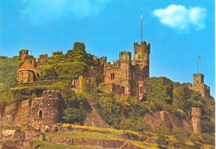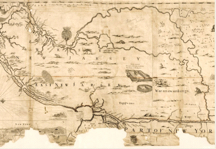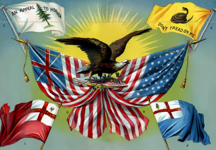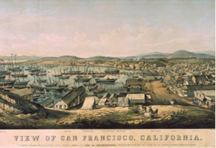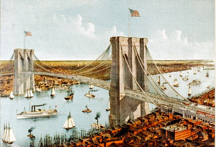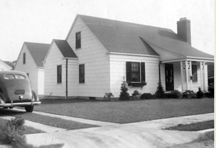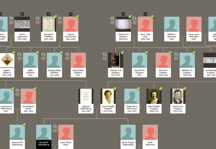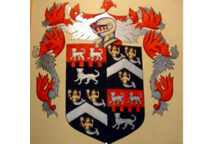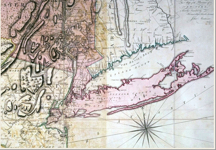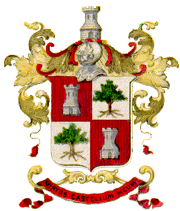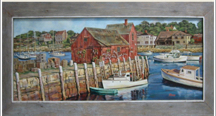The Falkenburgs,
An American Colonial Family

This history of the Falkenburg family is a view of one branch of family ancestry. It links 12 generations from Henry Jacobs Falkinburg to my grandchildren. The time line spans over three hundred fifty years of the family in America! I have attempted to tell this story not as a droll list of "who begat whom", but in a way which links the history of our nation to individual ancestors. The history of a nation is an aggregate of the histories of many individuals and families. There are some like George Washington, Thomas Jefferson, and James Madison whose stories have been recorded for posterity. But what about the many other individuals who have never made it into the history books? In their own way each had a significant impact within their own sphere on this emerging nation.
Over the span of history of our family in America, there have been many spellings of the family name. In the colonial period, the was most common was Falkinburg. In my branch of the family Falkinburg morphed to Falkenburg in the later part of the nineteenth century. If you look at historical records, you will see many variations including Falkinburge, Falkinburgh, Falcombre, and Falkenberg, Falkinbury, Fortenbury, as well as others. In my work, I use the spelling Falkinburg in the early history and later in my branch of the family Falkenburg.
Download from the iBooks Store
This book is available as a free download on the iBooks Store. If you have an iPad, go to the iBooks application and go to the iBooks Store by selecting one of the icons at the bottom of the screen (like Featured). In the search window enter the Falkenburgs. There is no need to download a preview as the iBook is free. You can also download an iBooks app for any OSX device (laptop or desktop) and access the manuscript in a similar manner.
Using the iBooks version, you get a fully functional multitouch book. For example, each of the references is hot linked within the text. If you click on one of these references, a new window will open with your internet browser and the linked material will be displayed. There is also a Gallery of pictures in the multitouch book that will allow you to leaf through an album of pictures of the Falkenburg Castle on the Rhine River. There are INTERACTIVE pictures in which you can zoom and pan.
I don't know if there are apps for Kindle or Android devices that suport iBooks. Please let me know if you have any information regarding this. (there are apps to read Kindle books and other ebooks on the iPad)
pdf version of the manuscript
I have postesd a pdf version of each of the fourteen chapters in the table below. The link to the pdf is just above the picture for that chapter. This is an option if you cannot access the multitouch iBook. A pdf document can be opened using (1) an internet browser, or (2) a pdf reader. If you click on the link to access the manuscript, the way the file opens depends on the configuration of your browser. I have my browser configured to open pdfs in my Safari Browser (OSX). However, once I have opened it, I have the option to view it in a pdf viewer (in my case Preview on the Mac). If you are viewing the pdf version of the manuscript and have the option, view the file using a pdf viewer (e.g. Acrobat Reader or Preview, or one of many other apps designed for pdfs). If you are able to do this, web links embedded in the text will open a window in your internet browser. When you are finished viewing the on-line resource, simply close the browser window.
If you open the pdf file directly in a web browser, everything works fine until you try to open a link to a web resource. A link will open in the same window (or tab) in which you are viewing the pdf. If you use the back button on your browser, you will NOT RETURN TO THE PAGE YOU LEFT WHEN YOU ACTIVATED THE LINK. You will return to the beginning of the book. This can be (to say the least) distracting. This is not an easy fix, as the underpinning models of pdf documents and html pages are different.
I have added a second pdf for each chapter that contains only the references. This is located just below each chapter picture. If you want to explore web-links, open both of these pdfs. They are set to open in different windows (or tabs). When you see a link you want to follow, go to the references pdf and open it there by selecting the bracketed number. When finished hit the back button for this browser window. Return to reading the text in the chapter pdf. I know that this is not an optimal solution, but this is at least workable. The BEST solution is to use the iBooks version if you have iBooks or find an iBooks compatible app for your device. Not only will you avoid problems with accessing links, you will be able to use the other interactive features of the iBook.
This manuscript is divided into fourteen chapters. The first part of the book focuses on the Falkinburg/Falkenburg trunk of our family tree. The book concludes documenting some of the families linked to Falkenburgs through marriage. The table below contains links to individual chapters.
The Falkenburgs: A Colonial American Family
| This introductory sections contains the title page, dedication, and forward. | |
| Legends, Myths and Castles sets the stage for the my story of the Falkenburg family. Our family name is steeped in history. It has roots in teutonic legends and stories of knights. Throughout the modern country of Germany there are a number of castles which have the name Falkenburg. Perhaps, the family had its origins in one of these castles. Records do not reveal this, but it is fun to speculate. The Falkenburg story I have found is every bit as interesting as if we were descended from one of these royal castles. | |
Colonial Roots introduces the establishment of our Falkenburg family in the Delaware colony of New Sweden in the third quarter of the seventeenth century. Paterfamilias Henry Jacobs Falkinburg became an envoy to the native Lenape people and negotiated land with them to build William Penn’s Quaker colony. Henry moved to the coast of New Jersey around 1700. You will meet his son Jacob Falkinburg, often called Henry, jr. Jacob married Penelope Stout, who has a very interesting story associated with her Dutch roots. The first two generations of the Falkenburgs were strongly influenced by their faith as Quakers. |
|
| Founding a Nation follows our Falkenburg family from the colonial era to the War for Independence. You will meet John Falkinburg, grandson of Henry Jacobs Falkinburg. I tell the story of the British attack on the Quaker community of Little Egg Harbor, New Jersey and the impact it likely had on our family. After the Revolution, John, like many Americans of his time, saw opportunity near the frontier of the nation; John moved to Cumberland County, Pennsylvania, where he purchased a saw mill and grist mill. I follow our genealogy through John’s son Samuel Falkinburg, who moved even further from costal New Jersey, settling in the Finger Lakes region of New York State. I present bio sketches of two of John’s Brothers: Somers Falkinburg and Joseph Falkinburg. Joseph served as both a representative and senator in the New Jersey Legislature. A final bio sketch follows several generations of John (son of John Falkinburg). This branch of the family works in the emerging Pennsylvania oil industry. Later generations move west to the Los Angeles Valley. Here we meet Nelson James Falkinburg (Sam Nelson) a famous Hollywood movie producer from 1920s thru the1980s. | |
| Down to the Sea explores our family from the last decade of the eighteenth century to the third quarter of the nineteenth. You will meet Captain Samuel Falkinburg and learn about his very large family, including my 2nd great grandfather, George Harrison Falkinburg, and Solomon, my great grandfather. Both followed their father Samuel in coastal maritime trade as captains and masters of merchant trade vessels. During this period of time, the United States once again engaged in war with Great Britain ostensibly over maritime rights. During the War of 1812, the British invaded our nation’s capital, burning the White House. By far the most disruptive event in period was the U.S. Civil War. Additional Resources | |
| California Gold focuses on two sons of Captain Samuel Falkinburg who set off to seek gold in California—Captain Charles Falkinburg and his brother Nelson Hance Falkinburg. These young men were 23 and 20 years of age when they led the Connecticut Mining and Trading Company on an expedition through the Straits of Magellan to the gold fields of California. | |
| Brooklyn Roots My branch of the Falkenburg family lived in Little Egg Harbor and Tuckerton since about 1700. Between 1870 and 1880, my great grandfather Solomon Falkenburg moved the family to Brooklyn, New York. Solomon was a sea captain involved in maritime commerce along the eastern seaboard. New York was the center for commerce and an ideal place for the family to relocate. This chapter explores the lives of Solomon and Annie Falkinburg, along with their children as they set up a new life in New York. | |
| This chapter entitled Reminiscence is structured different from the rest of the Falkenburg story. This chapter tells the story from my recollection of life as I was growing up. My focus here is how I have seen events shaping our nation, and not so much on what I have accomplished. As I enter my seventy-fifth year, I look back on all of the changes that have occurred during my lifetime. Progress seems to be accelerating in an ever more complex world. | |
| Allied Families sets the stage for the remaining chapters of this book. Clearly, our family tree has many more branches than we have talked about in the first seven chapters of this book. The presentation so far has been rather one-dimensional, following the main trunk of our Falkenburg family. In the remaining chapters we will explore several branches that join the Falkenburg tree through marriage. | |
| The Lippincott family joins the Falkenburg family with the marriage of my great grandfather Solomon Falkenburg to Ann Nancy Lippincott. This is another branch of the family with deep roots in Colonial America. Like many members of our colonial family, the Lippincotts were devoted members of the Society of Friends. Their religious beliefs impacted their lives and the history of our family. | |
| The Robbins Family joins the Falkenburg family with the marriage of my paternal grandmother Juliet P. Robbins to Samuel Edgar Falkenburg. While the Robbins family had its roots in England, our branch has been in America since colonial times. | |
| The van Voorhees/Voorhis Family is said to be the largest Dutch family in the United States. Steven Coerte van Voorhees was born in the province of Drenthe, Netherlands in 1600. At the age of 60, Steven brought his family to the colony of New Netherlands and settled in the community of Nieuw Amersfoort (Flatlands) in current-day Brooklyn, Long Island. My maternal grandmother Juliet Robbins Falkenburg descends from this Steven. Our van Voorhis family lived on Long Island for more than three hundred years. | |
|
|
Knight Gregson The Knight Gregson family joins the Falkenburg family with my mother Jessie Knight Gregson. Like the Robbins family, the roots of the Gregsons go back to the 1066 Norman conquest of England. The Knight Gregson family was created when Henry Knight inherited the Gregson family estate Lowlynn from his cousin Anthony Gregson in 1831. |
| The Rossi family joins our Falkenburg line with the marriage of Donald Falkenburg to Liane Marie Rossi. Liane’s parents were Lenore and Eugene Rossi. The following story draws upon an account that Gene Rossi gave in his 94th year while living Independence Village, a retirement home in Brighton, Michigan. | |
| This Epilogue is a look toward the future. It explores the challenges facing the next generations of our family, as they continue to support and grow the American dream. |






